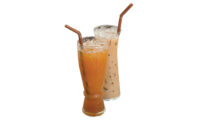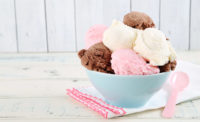When it comes to some key nondairy beverage categories, the spin of the wheel has been kinder to some categories than others. The odds have been in ready-to-drink (RTD) coffee and tea’s favor, while juice seemingly is facing a gaffed wheel.
Juice is chasing losses
Although a staple within the U.S. beverage market, the juice and juice drinks category has been challenged as other beverage categories have emerged as go-to options for consumers in terms of hydration and refreshment. Global market research firm Mintel highlighted the obstacles the juice market has faced against these other categories in its June 2018 report titled “Juice and Juice Drinks – U.S.”
Milk | Cheese | Cultured | Ice Cream | Butter | Non-dairy Beverages | Ingredients | Exports
“Competition from other drinks is hurting juice sales,” the report states. “Consumers do not have as strong associations with juice as they do with other beverages. For example, if a consumer wants hydration, he’ll likely choose water over juice.”
Mintel’s report points to sugar concerns on the part of consumers as one of the culprits.
”Forty-one percent of consumers who don’t buy 100% fruit juice say the high amount of sugar in the juice prevents them from making a purchase,” the report states. “Unfortunately, because the sugar in 100% fruit juice is natural, 100% fruit juice brands can’t just lower the total amount of sugar in the drinks. Instead, juice brands need to diversify product offerings and identify new opportunities through product innovation.”
Gary Hemphill, managing director of research for New York-based Beverage Marketing Corp. (BMC), said the industry is seeking to address these concerns. For example, the Washington, D.C.-based Juice Products Association launched sipsmarter.org, a website dedicated to educating consumers about the science-backed health and nutritional benefits of 100% juice.
“More than 80% of Americans do not eat the recommended amount of fruits and vegetables. One-hundred percent juice is an easy, tasty way to incorporate more fruits and vegetables into your diet,” said Diane Welland, registered dietitian for the Juice Products Association, in a statement at the time of the website’s launch. “We hope that the Sip Smarter website and campaign will educate consumers seeking facts about juice and inspire them to feel good about enjoying juice as part of a balanced diet.”
In its report, Mintel notes how less-sweet juices could serve as a growth opportunity for the category.
“Twenty-seven percent of consumers say that most juice is too sweet, but this increases to nearly half of consumers who want low-sugar juice and don’t buy 100% fruit juice,” the market research firm said. “Since sugar content is a common reason why consumers don’t buy juice, there may be an opportunity for juice brands to connect with lapsed juice buyers through juices with a less-sweet flavor profile. Fruit juice blended with vegetables, coconut water and even spices/herbs may appeal to consumers who want less-sweet juices.”
The Campbell Soup Co., Camden, N.J., is addressing the dearth of less-sweet juices with the launch of V8+Hydrate. The plant-based beverage line uses sweet potato juice and contains one full serving of vegetables with no artificial sweeteners, the company said. Packaged in 8-ounce cans, the 45-calorie beverage comes in three flavors: Strawberry Cucumber, Coconut Watermelon and Orange Grapefruit.
In its February 2018 report titled “Juice in the U.S.,” Euromonitor International, with U.S. offices in Chicago, explains that implementation of the new Nutrition Facts label, which has been delayed until January 2020, could influence the future of juice product development.
“Most consequential will be the addition of added sugars on nutrition labels, which will play a defining role in helping to add validity to the term ‘healthy,’” the report states. “Already, Kraft Heinz has removed added sugars from a line of its immensely popular juice brand Capri Sun, showcasing the potential shockwaves the new labels may send through the juice market.”
Some good news: Super-premium juices have had a positive impact on the category.
“Super-premium juices and drinks are a bright spot in the overall fruit beverage market,” BMC’s Hemphill said. “They are growing while the overall category continues to decline.”
In BMC’s August 2018 report titled “U.S. Fruit Beverages through 2022,” the market research firm details that following a decline in 2009, the sub-segment grew in the eight subsequent years.
A part of the broader super-premium juice revolution, organic varieties have expanded juices’ reach in the marketplace. However, analysts caution that the reach likely will be limited due to price constraints.
“Organic is a net positive for the category, but organic products are more expensive, which may be limiting their growth,” Hemphill said.
Beverage makers also are finding new ways in which to position organic juices. For example, 4Pure Inc., Cumberland, Maine, launched a line of organic lemonades in three flavors: Original, Blueberry and Raspberry. Each is crafted from real lemon juice and peak-season fruit purees, and is lightly sweetened with sustainably tapped New England maple syrup, the company said.
Meanwhile, cold-pressed juice brand Evolution Fresh, a wholly owned entity of Seattle-based Starbucks Corp., doubled down on its mission to source quality produce by announcing a commitment to offering 100% organic products this year. Evolution Fresh said it works directly with farmers to source organic produce.
Given the mixed bag of variables impacting the juice and juice drinks market, BMC is predicting the juice and juice drinks market will contract during the next five years with a compound annual growth rate (CAGR) of -1.3%.
“While not a cause for celebration, this would represent the category’s best performance since 2001-2006’s compound annual growth rate of -0.9%,” the report says.
RTD coffee has the edge
Unlike the juice category, ready-to-drink (RTD) coffee has reason to celebrate.
“Ready-to-drink coffee is having the most positive impact on the coffee category, thanks to its high level of innovation and convenience; the innovation I’m currently seeing in RTD even rivals that of some of the top coffee cafes,” said Jill Failla, foodservice analyst with Mintel. “For example, there’s been a quick rise in the number of RTDs offering functional ingredients and benefit claims, from adaptogens to nootropics. Young consumers and Hispanic consumers are core consumers of RTD coffee, which bodes well for the continued future growth of this format.”
Euromonitor International credits cold-brew coffee, in part, for helping advance the RTD coffee market.
“Cold brew represents a small but growing proportion of RTD coffee sales in the U.S., and brands that are primarily or entirely cold brews, such as STōK, are the standout performers,” the market research firm says in its March 2019 report titled “RTD Coffee in the US.” “Cold brews appeal to consumers who are looking for an indulgent, coffee shop-style experience, as well as to those who seek a low-sugar functional energy boost.”
STōK Cold Brew, a brand of Broomfield, Colo.-based Danone North America, expanded its cold-brew coffee portfolio earlier this year with the releases of STōK “oatmilk” latte and STōK “almondmilk” mocha, two new dairy-free creamed coffees.
The RTD oatmilk latte features 135 milligrams of caffeine in each 12-ounce serving. The almondmilk mocha is complemented by chocolate and also has 135 milligrams of caffeine in each 12-ounce serving.
As consumers redefine health and wellness, nondairy innovations continue to proliferate the RTD coffee market.
“Nondairy milk alternatives are a large part of the RTD market’s innovation. Consumers are seeking them out for health and taste reasons alike, and unsurprisingly, interest is driven by Gen Z-ers and millennials,” Mintel’s Failla said.
As noted by analysts, cold-brewed and nitro-brewed RTD coffees also appeal for their ability to support sugar-reduction trends.
“I’m seeing more brands reformulate RTDs with lower sugar content and natural alternative sweeteners such as date syrup,” Failla says. “I’m also interested by the emergence of flash-brewed coffee, which has the potential to surpass cold brew as the cold coffee darling.”
BMC’s Hemphill notes that the RTD coffee market is catering to the evolving tastes of consumers, too, including reduced-sugar solutions.
“Ready-to-drink coffee marketers are offering a range of choices — some sweetened, some unsweetened and some with reduced sugar,” he said.
For its part, Loco Coffee, Holliston, Mass., launched a cold-brew blend with added coconut water for natural sweetness and electrolytes — without any added sugar or preservatives. The RTD coffee drinks provide the same amount of potassium as a banana, the company said.
RTD tea hitting a ‘big number’
RTD tea has a positive story to tell as well. In its September 2018 “Tea and RTD Tea — U.S.” report, Mintel notes that tea overall enjoys widespread usage, with 90% consumer participation.
And in its “U.S. Beverage Market Outlook 2019” report, the Packaged Facts division of Rockville, Md.-based MarketResearch.com says sales of all tea, including RTD, have been increasing at a CAGR of 3.8% since 2013.
“Overall growth of tea has been driven by convenient RTD teas, particularly refrigerated varieties (including kombucha), that have a more health aura than shelf-stable products,” the Packaged Facts report states. “Tea has also benefited from consumers’ ongoing recognition of its healthy properties, especially compared to sugary carbonated beverages.”
BMC’s Hemphill also pointed to the positive impact of the RTD category.
“In recent years, RTD tea has been outperforming the overall tea category,” he said. “Consumers are increasingly opting for the convenience of RTD products in spite of the fact that they are generally more expensive.”
Although tea offers numerous health benefits, industry experts warn that RTD might not offer those same benefits.
“While tea has strong connection as a [better-for-you beverage] BFY beverage, the RTD tea segment doesn’t necessarily share the same positive health halo. Three out of 10 tea drinkers agree that RTD tea is too high in sugar, and nearly a quarter think RTD contains too many artificial ingredients,” the Mintel report notes, citing a Lightspeed/Mintel survey of 1,809 internet users aged 18-plus who drink tea.
That said, whether it’s for antioxidants, an energy boost, a digestive aid or relaxation, the functional benefits of tea, including RTD tea, are a large draw for consumers.
“While functionality abounds when it comes loose-leaf teas on the market, the same now can be said for the RTD category,” the Packaged Facts report states. “RTD tea brands are increasingly distinguishing themselves by functionality. … Green tea itself is considered by many to be a superfood, as research shows it can improve brain function, prevent cancer and even aid in weight loss. Green tea has progressed into the mainstream and can be found in numerous popular RTD teas, like Snapple and Pure Leaf.”
MindFull Inc., Boulder, Colo., introduced its own version of a functional RTD tea beverage. Vibe is an RTD line of organic electrolyte teas made with artesian spring water, which includes naturally occurring electrolytes and minerals, the company said. Available in four flavors — Mint, Lemon, Peach and Pomegranate — Vibe has 48 milligrams of naturally occurring caffeine from USDA-certified organic black tea, 1 gram of sugar and 20 calories per 500-milliliter serving.
One particular subcategory of RTD tea — kombucha — recently has proliferated throughout the market. Fermented with bacteria and yeast, it is rich with probiotics, antioxidants, amino acids and enzymes, creating the kind of healthy-halo beverage toward which consumers are trending.
“Kombucha is one of the trendiest beverages, and refrigerated tea, which includes kombucha, is the fastest-growing segment of the tea market,” said Caleb Bryant, senior beverage analyst at Mintel.
Even with its rapid growth, kombucha still is fairly niche within the category; only 23% of consumers drink it, compared to 75% who drink bagged hot tea, Bryant said.
On the more progressive side, as the beverage world continues to explore the realm of cannabis-infused beverages, RTD tea is positioned well for the green ingredient, Bryant noted.
“Tea lends itself well to CBD/THC infusions, as both substances, tea and cannabis, are associated with relaxation,” he said. “From our ‘Recreational Cannabis User’ report, 34% of consumers aged 22-plus in states where it is legal
to purchase cannabis for recreational use who consume cannabis or are interested in consuming [it] would be interested in a cannabis-infused tea.”
*Note: This article was condensed from three separate 2019 articles appearing in Beverage Industry, a sister publication of Dairy Foods. The authors are Jessica Jacobsen (juices, coffee) and Taylor Karg (tea).
Milk | Cheese | Cultured | Ice Cream | Butter | Non-dairy Beverages | Ingredients | Exports











